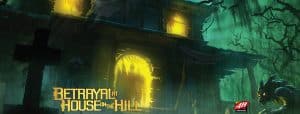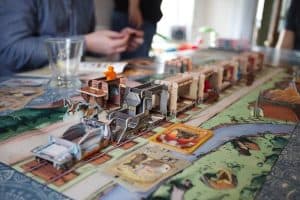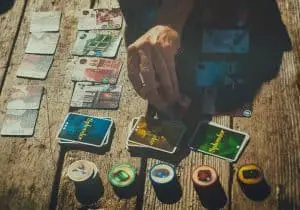“Mom, trust me I am not a werewolf – I am your son would I lie to you?!”.
Of course I was a werewolf! Welcome to the world of hidden identity board games – where bluffing and bargaining is not only part of the game but encouraged!
Hidden identity (or social deduction) board games are the perfect games to play when you have a decent size group of people together. They make brilliant party games, as they force interaction and don’t require a huge time commitment.
Hidden identity games involve players deceiving, lying, plotting and ultimately betraying their fellow friends – the perfect social bonding experience!
Games usually start with each player knowing their own identity, with a few randomly chosen traitors in the mix that need to put their acting skills to the test.
Traitors need to play along and cooperate with the other players while secretly planning to stab them in the back.
Below is a list of what I believe to be the best social deduction games on the market currently – every one of these games is incredibly fun to play and often gets pulled out at parties or get togethers with my friends and family.
Top 11 Best Hidden Identity Board Games
- Mafia
- One Night Ultimate Werewolf
- Shadows Over Camelot
- Battlestar Galactica
- Love Letter
- Two Rooms and a Boom
- The Resistance: Avalon
- Secret Hitler
- Crossfire
- Ultimate Werewolf: Deluxe Edition
- Witch Hunt
1. Mafia
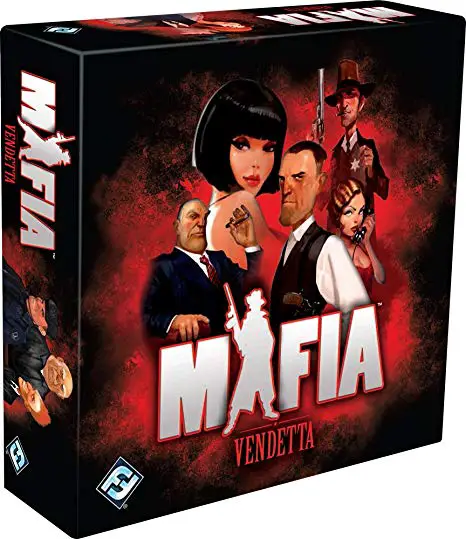
Players: 7 – 36
Duration: 30mins
Mafia (also known by the name ‘Werewolf’) was one of the first hidden identity board games and was designed by psychology student, Dmitry Davidoff while studying at the Moscow State University in 1986.
The game is still regarded as one of the best social deduction board games today.
In fact, in my opinion it is one of the best party games to play if you have a large group of people.
It requires no fancy equipment except a few cards (provided with the game), it is easy to learn and has the perfect amount of lying, bluffing, guessing, assassinations and chaos!
Gameplay
The premise of the game is that the Mafia have set up shop in your town. Understandably the villagers are upset and decide to band together and take out each mob member, one by one.
The problem? No one knows who is in the mafia and who isn’t.
The game is played in alternating day and night cycles starting with night.
At the start of the game each player is handed a card with their identity – either a civilian, Mafia gangster or the moderator (2 Mafia in a group of 7 – more if there are more players).
This identity is kept secret by each player (except for the moderator).
Every day the villagers meet to vote on who they believe is a suspected Mafia member – and that member gets taken out.
There’s a catch however… each night the Mafia also meet, and they vote on a civilian to take out.
Night Phase: All civilians need to close their eyes. The Mafia then need to decide on which civilian to kill (silently) by pointing or signing.
Once the civilian who is killed is decided. The moderator tells everyone to open their eyes and identifies the person the Mafia killed during the night. This person is out of the game.
Day Phase: All players – both Mob and Civilians need to discuss and vote on a player to kill. The Mafia obviously want to kill an innocent villager, while the villagers want to kill a mob member.
Once voted upon, the moderator declares that person dead and they flip over their card – revealing whether they were a Mob member or an innocent.
The cycle then repeats.
For the Mob members to win the game they need to kill enough villagers so that the number of gangsters and villagers is even.
For villagers to win – they need to kill all gang members.
There are also a lot of other special cards that can be played in the game that add special characters with special abilities that differ from the base game such as – a seer, doctor, rival gang, lawyer etc. These characters have special abilities that can be used during the cycles and adds a bit more complexity to the game.
Pros:
- Brilliant party game – lots of fun in a large group
- One of the first hidden identity games
- Simple to set up and play
Cons:
- Mafia members need to be very quiet during night – or it can ruin the game
- Even numbers can make day cycles even in votes (rarely happens).
2. One Night Ultimate Werewolf
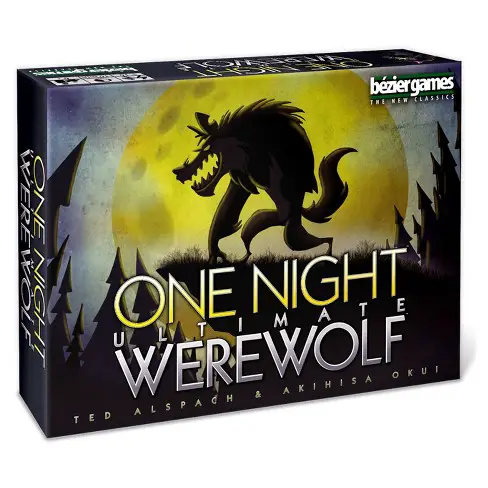
Players: 3 – 10
Duration: 10mins
If you have a slightly smaller group than 7 people, this game is a great alternative to Mafia.
One Night Ultimate Werewolf is a fast-paced hidden identity game that only takes 10mins to play.
The games premise is that there are suspected werewolves that have infiltrated a village.
There is one day before the full moon, and the villagers have the day to decide who the werewolves are and dispose of them before they transform that night and kill them all.
Ultimate Werewolf is another great party game. It’s quick, so people aren’t ever waiting around and, if someone gets a role, they don’t particularly like… it doesn’t last very long.
Note: There is an app for the board game that can be downloaded for iOS or Android that acts as the moderator and is 100% worth getting!
Gameplay
The game has 16 role cards and 16 tokens.
Players are divided into two groups: werewolves and villagers by randomly passing out one token to each player.
Everyone is dealt a card and three are placed face down in the middle of the table.
I mentioned above that there was an app for the game – let me stress that it is totally worth downloading and using. Not only because it is hilariously over dramatic, but because it’s the perfect way to learn the game for beginners.
The app walks players through every step of the game. First asking everyone to close their eyes.
Werewolves are then told to open their eyes so that they can identify each other (or if there is only one werewolf – look at one of the cards in the center of the table). Werewolves then close their eyes again.
In the game – players that are villagers all have unique roles with special abilities.
For example: The seer is able to choose one other players card to look at and the robber is able to swap his card for anyone else in the groups card.
Each player is woken up at different points and their ‘action’ is completed.
Once all actions are completed all players open their eyes. This is where the fun begins!
All players need to discuss what has happened and decide (by vote) who to kill.
The villagers win if they kill at least one of the werewolves. The werewolves win if they all survive.
Pros:
- Game is over in 5 – 10 mins
- Smart App is really useful
- Unique roles make the game really interesting
- Easy Set up
Cons:
- The game lacks any real depth to be the sole focus of a game night or party
3. Shadows Over Camelot

Players: 3 – 7
Duration: 60mins – 90mins
Shadows Over Camelot is a game that I have only recently been introduced to. It’s an older game (released in 2005) that combines aspects of role playing, cooperation and hidden identity games into a game that is super fun to play!
It won the esteemed Spiel des Jahres award in 2006 for the best ‘Fantasy Game’.
The game play is simple enough for even beginner gamers to learn, but has a tiny margin of error for the good guys (the knights) that means any significant mistake is going to result in a loss.
The game is set in the age of King Arthur – with knights trying to overcome different quests tasked upon them – from defeating the black knight to searching for the holy grail. With the overarching goal to save Britannia.
Gameplay
At its core, the gameplay mechanics of Shadows Over Camelot is very simple.
Players are assigned a knight to play at the beginning of the game. These knights are unique and have their own special abilities.
There is a twist however, that one of the knights could be a traitor to the group – this is where the hidden identity aspect comes to play.
The tricky part of the game is that on each turn, each player has to perform two actions:
1. One action is a good action; and
2. One action is a bad action that benefits the forces of evil.
In other words – with this mechanic, it is incredibly hard to figure out who the traitor is AND every turn the knights are one step closer to losing!
An example of an action a player can take for the good of the knights is progressing quests (which are key to the game). These actions are determined by the action cards the player has in their hand.
Hand management is a hugely important part of the game – and encourages lots of discussion among the group (even from the traitor – who will obviously have ulterior motives of what players should do).
An example of an evil action would be activating an ‘event card’. These are cards that make performing actions or quests significantly harder.
The game is played on a turn by turn basis until the Knights overcome the quests and progress far enough in the game to save Britannia OR the forces of evil overcome them and the traitor emerges victorious.
Pros:
- Simple mechanics
- Great combination of coop gameplay with hidden identity mechanics
- Quality of game pieces and cards is excellent
Cons:
- Gameplay is very simple – won’t appeal to hobbyist gamers
- Game is very difficult for knights
4. Battlestar Galactica
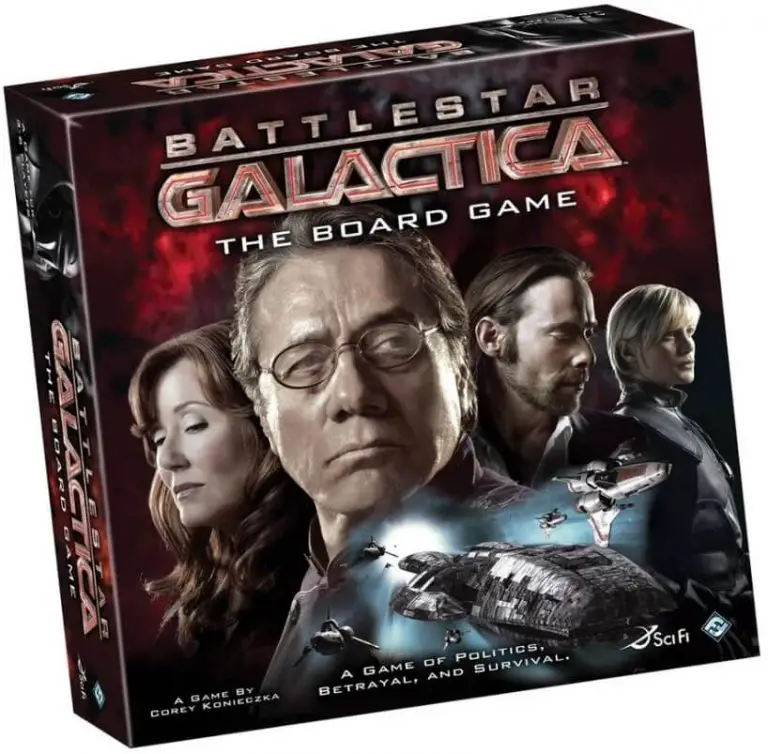
Players: 3 – 6
Duration: 120mins – 180mins
Battlestar Galactica is based on the TV show of the same name. If you are a fan of the show, or sci-fi in general then this is a great hidden identity game for you.
The game takes you on a journey through space playing as human players that are trying to overcome the Cylons (baddies).
Throughout the games the human players will try to survive and overcome the tasks presented to them in order to keep Galactica flying while the secret Cylon players will do everything to stand in their way.
Gameplay
At the start of the game players are each dealt a ‘loyalty card’. These cards will determine where the players allegiance lies (human or Cylon). Players also choose a character to play from the TV series. Each character is chosen from categories (Pilot, support, military leader etc).
Characters all have unique traits, skills and one-time use abilities.
Humans have one task. Keep Galactica flying and intact so that it can jump to the planet Kobol and overcome the Cylon invasions.
Cylons, need to stop this happening at all costs.
Players play the game in turns. Each turn has 4 steps:
1. Skill Cards – Players draw a card from the skill card pile depending on their character type. These cards progress your character in the game.
2. Move – Players are able to move their characters to different areas of the ship. These areas allow different actions like shooting the ships guns or flying the ship.
3. Action – Players are allowed to use one action each turn. This can be using a card from their hand, using their characters abilities or using the part of the ship they are in.
4. Crisis – At the end of a players turn they need to pick a ‘crisis card’. These are always bad cards for the humans. The majority of these cards are either fail or pass – measured by a skill check mechanic.
During points of the game the ship is ‘jumped’ to new planets – the distance the ship is traveled is tracked along the way.
Once the ship has travelled a distance of 4. Every player needs to pick new role cards.
Yes, you heard that right! You thought you were playing a human the whole game – well guess what you might have been an undercover Cylon agent the whole time!
At some point the Cylons will reveal themselves. Once this happens a whole new set of actions opens up to them – from attacking Galactica with an enemy fleet to playing a ‘Super Crisis Card’.
In order to win, humans need to keep Galactica alive long enough to reach a distance of 8 and then jump to Kobol.
Cylons need to destroy Galactica or drain one of its four resources to 0 before they get there!
Pros:
- Awesome traitor mechanic – it could be until halfway through the game until you realize you were a Cylon agent all along!
- Great Sci-Fi theme
- Co-op aspect of the game is really fun
Cons:
- Luck plays a small role in the game
- It’s a very long game to play
5. Love Letter

Players: 2 – 4
Duration: 20mins
Love letter is a very simple, yet incredibly fun game to play. The game comes with 16 cards (only 8 unique cards) and a few red cubes, but don’t let this fool you. The game is able to pack a lot of interesting interaction and strategy into these few components.
The theme of the game is that there is a princess who has locked herself inside a palace. All the eligible young (and not so young) men are trying their hand at wooing the princess and winning her heart by sending her love letters.
There is a trick though – you want your love letter to reach the princess first AND you can’t deliver it to her personally. Instead you have to use those connected to her to deliver your letter, while exposing the efforts of the other players before they can do the same to you!
The game is a ton of fun, quick to play and easily portable. It has also won a slew of awards including the 2013 Golden Geek Most Innovative Board Game Winner.
Gameplay
Set up of the game is very easy, simply shuffle the deck of cards and hand one to each player. One card is then discarded from the deck (without showing the identity of the card to the players).
Note: If playing with only 2 players then an additional 3 cards are also discarded.
These cards represent one of the people connected to the princess. They each have a number on them from 1 to 8 and a description with an ‘ability’ they can use.
Each turn a player draws a card from the deck and then plays one of the cards in their hand (which activates that players ability). An example of an ability is the Guard – the guard is able to attempt to guess one of the other players cards. If you get it right, that player sits out of that round.
This is where the hidden identity element comes in to play in Love Letter. You do not want the other players to know what cards you are holding.
You have to use your deductive abilities to try to get an edge over the other players, by knowing which cards have been played, which you hold and what is left to play.
Play is continued until one player is holding the last suitor card or until the draw card pile runs out. If this happens all players turn over their cards and the player with the highest score (calculated by adding up the numbers on all cards) wins.
The winner of a round receives a red cube (which is supposed to represent a rose from the princess).
Players can determine whether the winner is the best of 3 or 5 or more depending on how many rounds of the game they want to play.
Pros:
- Portable – can be carried in a bag or purse
- Very easy to learn
- Perfect to play with all ages
Cons:
- Luck plays a big role
- Theme is a bit feminine (However there are hobbit and batman versions!)
6. Two Rooms and a Boom
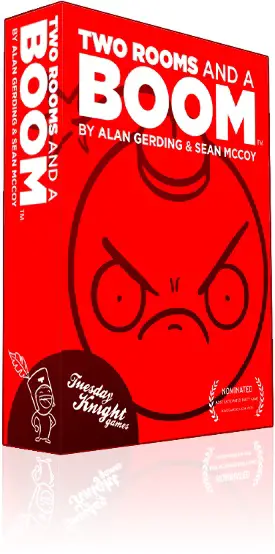
Players: 6 – 30
Duration: 7mins – 20mins
Two Rooms and a Boom is another entertaining party game if you have a large group of people.
It is a hidden role game where players are split between two separate rooms (it’s all in the name!).
The premise of the game is that there is a red team and blue team. The red team has a bomber and the blue team has a president. If the bomber and the president are ever in the same room… BOOM!
I absolutely love playing this game during parties. It is super easy to learn, and after a few beers it becomes super competitive!
Gameplay
The game comes with a box full of 110 character cards, a character guide, rule book and leader cards (for the leader of each room).
The game is very simple. The character cards are shuffled and one is given to each player. This will tell them which team they are on (red or blue) and the role they play on the team (including whether they are the president or the bomber).
Once all cards are handed out the players are randomly separated into two separate rooms.
Here they are able to have discussions and (if they wish) reveal their character cards or which color team they are on. The aim is to learn as much as possible about your team mates, who they are and particularly who the president or bomber is.
In the rooms the teams will also elect a leader who is given the leader card.
During the game there are 5 rounds. These rounds are timed and the time gets successively shorter each round.
In the room’s players can act or say whatever they want. There are no rules. This is where the hidden identity aspect of the game beings to rear its head.
The bomber and the president are unlikely to want to reveal too much. Anyone that is holding back is usually deemed ‘suspicious’.
After the time limit is up. The leader of each team will meet up and send a number of players from their own teams to the other room and vice versa. These are ‘hostages’.
The number of players transferred between each room decreases every round until the 5th round where only one person from each room is swapped.
After this happens the president and bomber need to reveal themselves. If they are in the same room – Red wins. If not, blue wins.
The game is so simple yet incredibly effective in a party setting. I have found Two Rooms and a Boom the perfect game to play when meeting new people to break the ice and have even been able to recruit a few more players to my game nights from it!
The game also has a lot of replayability with the introduction of special roles. For example – you can have the ‘doctor’ and ‘engineer’ roles.
To win the game – the doctor must co-reveal identity with the president to give the president his medication and vice versa for the engineer who must co-reveal himself to the bomber to fix his bomb.
These are fantastic addons to the game for players that have played a few rounds – however for beginners, its worth just sticking to the basics.
Pros:
- Great social party game
- Lots of replay value
- Good quality components
Cons:
- Requires everyone to be ‘in’ the game
- The nature of the game means there is a luck aspect
7. The Resistance: Avalon
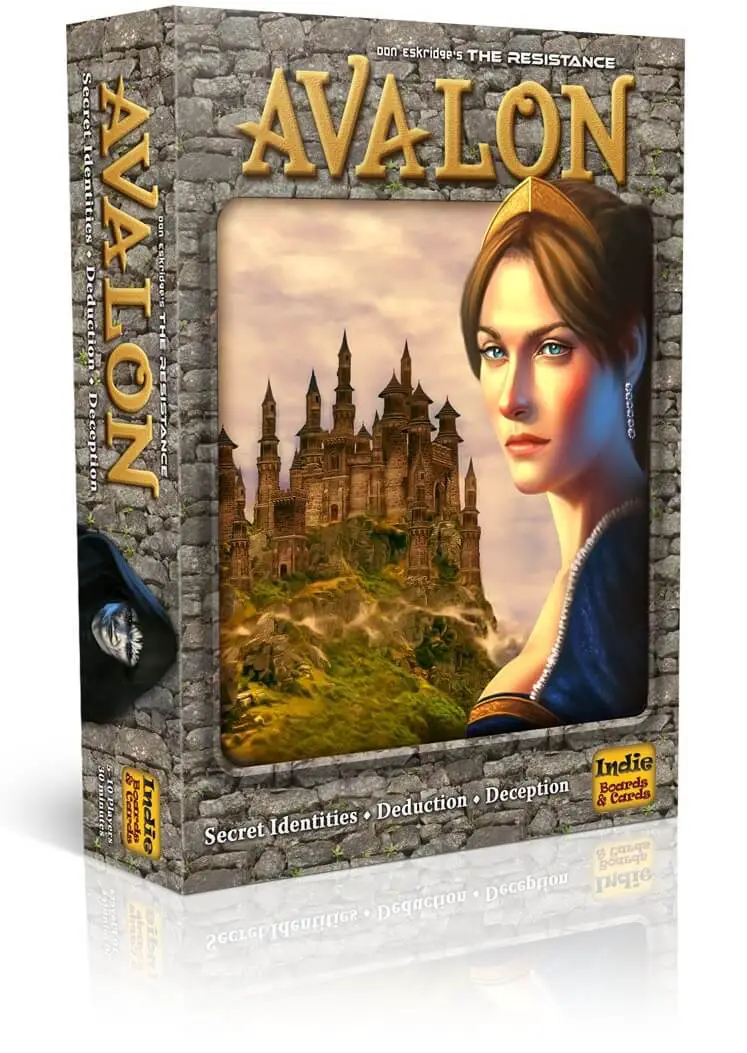
Players: 5 – 10
Duration: 30mins
The Resistance: Avalon is another game that like Shadows Over Camelot is based in the time of King Arthur in Medieval Britannia.
The games theme is similar to Shadows as well, whereby players are either loyal to King Arthur and his cause or are minions of Mordred (the bad guys).
The game is a reskin of the popular game ‘The Resistance’, but has additional roles that make this game unique.
Gameplay
Like all hidden identity board games, players are randomly assigned a character and allegiance at the start of the game.
All players then go through a dialog that allow the evil players (minions of Mordred) to know who each other are.
The games rules are very simple. There are 5 quests the players need to work through during the game.
Winning the game means succeeding to complete 3 out of 5 quests for the good guys, or failing 3 out of 5 quests for the minions.
At the start of a round a player is assigned a leader of that round. This player will propose which players should form the team to go on a quest (each quest has different player number requirements to complete).
The players then vote whether they agree on this team or not. If no agreement is reached – then the next person will propose a team until one is agreed upon.
The players that embark upon the quest will have mission cards. These are cards that either say ‘Success’ or ‘Fail’.
Players play one of these cards in secret. These cards are then shuffled and then turned over.
If a single card says ‘Fail’ then the quest has failed.
Discussions during rounds can become super intense as players throw accusations about who they think is good or bad and the minions lie through their teeth to stay hidden!
The game also has role cards that can be added to change mechanics. Such as the Merlin or Assassin cards – Merlin gets to know at the start of the game who the minions of Mordred are, but he has to be very subtle as, at the end of the game the Assassin gets one choice as to who Merlin is.
If the Assassin is correct – the Minions win.
Pros:
- Very easy game to learn and play
- Adds to the hugely popular Resistance game
- High quality components
Cons:
- Game relies on players bluffing
- If you already own Resistance – the only change is 10 additional loyalty cards
8. Secret Hitler

Players: 5 – 10
Duration: 45mins
Created by a number of prominent board game Designers (including Cards Against Humanity’s Max Temkin), Secret Hitler raised over $1.4million in a very successful Kickstarter campaign.
Now this game is going to be a controversial. The theme is obviously not going to be for everyone.
However, if you can look passed the theme, as a game, Secret Hitler has a lot to offer.
The game is set in 1930’s Germany and revolves around the liberals and fascists. The goal of the fascists is to create distrust within the group and make sure their leader (Secret Hitler) is installed as Chancellor.
Gameplay
At the start of the game all players are dealt a card that details whether that player is a Fascist, a Liberal or the Secret Hitler.
All players then close their eyes and all non-Hitler Fascists are able to open their eyes and identify one another (as well as the Secret Hitler who will have his eyes closed but thumbs up).
The Liberals will always outnumber the Fascists.
Each round a player will be chosen to be the ‘President’ and another will be the ‘Chancellor’.
The President title moves around the table each turn. The Presidents role is to nominate a player for Chancellor. The other players then vote – and if there is a majority, then that player is the Chancellor for the round and is able to pass a law chosen from two policy cards given to him/her by the president.
The goal of the game for the Fascists is to pass as many Fascist policies as possible OR elect Hitler as the Chancellor (this ends the game).
The Liberals want to pass as many Liberal policies as possible OR assassinate Hitler.
The policies on the board are just counters. However, if a certain number of Fascist policies are passed – the president gets special abilities:
- If 2 Fascist policies are passed – the president can look at any players party association.
- If 4 Fascist policies are passed – the president can assassinate someone and remove them from the game.
Fascists are only able to win the game by electing the Secret Hitler if there are at least 3 Fascist policies that have been passed.
Overall, the game is hugely entertaining. Even if the theme is a bit too ‘real’… I urge you to give the game a go and try to overlook this fact – it is a whole lot of fun even if it isn’t politically correct.
Pros:
- Fast, simple and fun to play
- Great art work and quality of components
- Perfect gateway hidden identity game
Cons:
- Theme is not for everyone
- Need a group of 6 to 8 for ideal numbers
9. Crossfire
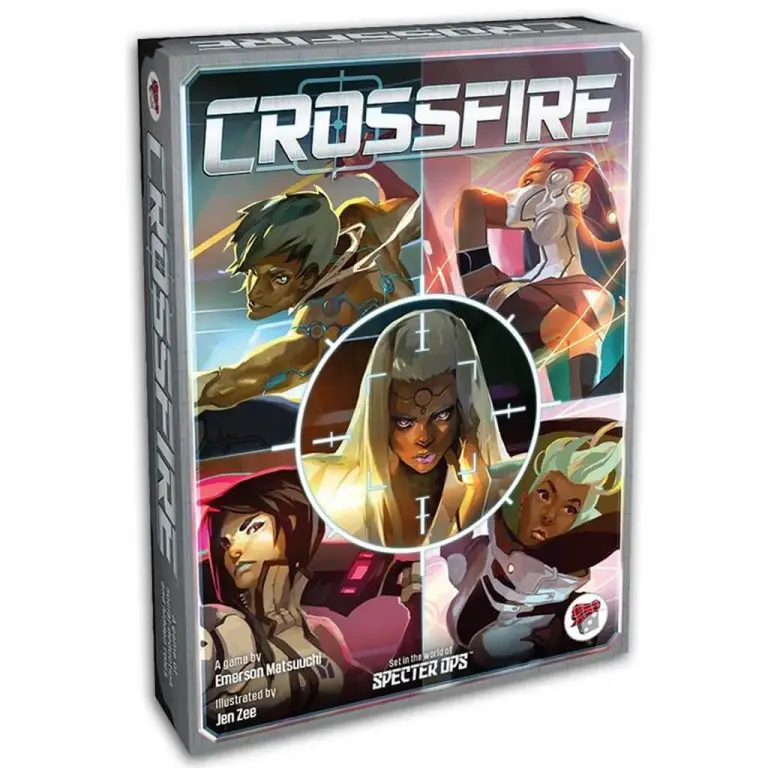
Players: 5 – 10
Duration: 5mins – 10mins
Crossfire is a quick and easy game to play that is a lot of fun if you are short on time or want to play multiple rounds in quick succession.
The game is futuristic game set in the Spectre Ops universe and focuses on protecting a ‘VIP’ whose life is threatened by multiple assassins who are camouflaged amongst the crowd.
Players play as the VIP, Assassins, agents, decoys or innocent bystanders.
Gameplay
The way Crossfire assigns players their role is a bit different to the other hidden role games we’ve looked at so far.
Each player is dealt a card with a role on it at the start of the game. The players look at their card and then passes it to the player on the left.
After this, every 3rd player at the table shuffles their role cards with the neighbors on either side of them and deals them back out again. This is now everyone’s final role.
Once everyone has their roles – a timer is set for 3 mins.
During this time the players have a chance to discuss and make accusations and claims about who they think are the assassins or the agents and who the VIP is.
At the end of the three minutes everyone must instantly ‘finger gun’ (point) at the player they want to assassinate/kill.
This will determine who wins and who loses the game.
Only Assassins and Agents have guns. Therefore, only the people these players point to die.
The win / loss conditions of the game are as follows:
- Innocent bystander – Only needs to survive to win;
- Assassins – Win if the VIP is assassinated;
- Decoy – Wins if they are killed;
- Agent – Wins if the VIP lives.
There is also the possibility to add in other specialty characters if you have a large group such as the Enforcer (who has 2 guns), Bodyguard (instead of killing his target he protects him) etc.
The game is over superfast, but it’s a blast to play. There is a lot more negotiation in Crossfire – as there is not a vote in the game. It’s a decision that is made instantly.
The time limit makes the game even more intense as everyone is rushing to convince everyone of their ‘story’.
Pros:
- Super-fast game play time
- Easy to set up
- Beginner friendly
Cons:
- Many of the addon roles are a bit ‘eh’
- It sucks if at the end of the round you don’t have a gun
10. Ultimate Werewolf: Deluxe Edition
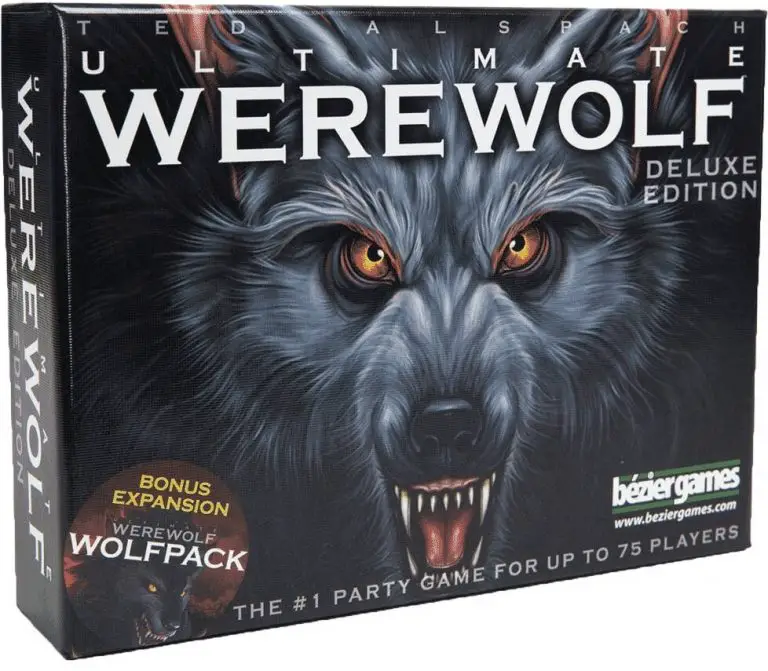
Players: 5 – 75
Duration: 45mins
Ok so this game is best played with 75 people….
Only joking… but the fact it’s able to be played with that number of people is insane!
Ultimate Werewolf is a return to the werewolf theme. Villagers vs Werewolves. In fact, it’s essentially the exact same game as One Night Ultimate Werewolf, except instead of the game being over in one round – there are multiple night and day cycles.
Gameplay
This game plays exactly like One Night Ultimate Werewolf so I won’t go into too much detail here.
The main difference is that this game is played over multiple rounds and can host a lot more people.
Ultimate Werewolf also changes how each of the characters work – you can read more about the differences here.
Pros:
- Can host up to 75 players!
- Played over multiple rounds
- Great artwork and quality of components
Cons:
- If you are voted out early. It sucks.
- Even numbers of players can cause ties with votes
11. Witch Hunt
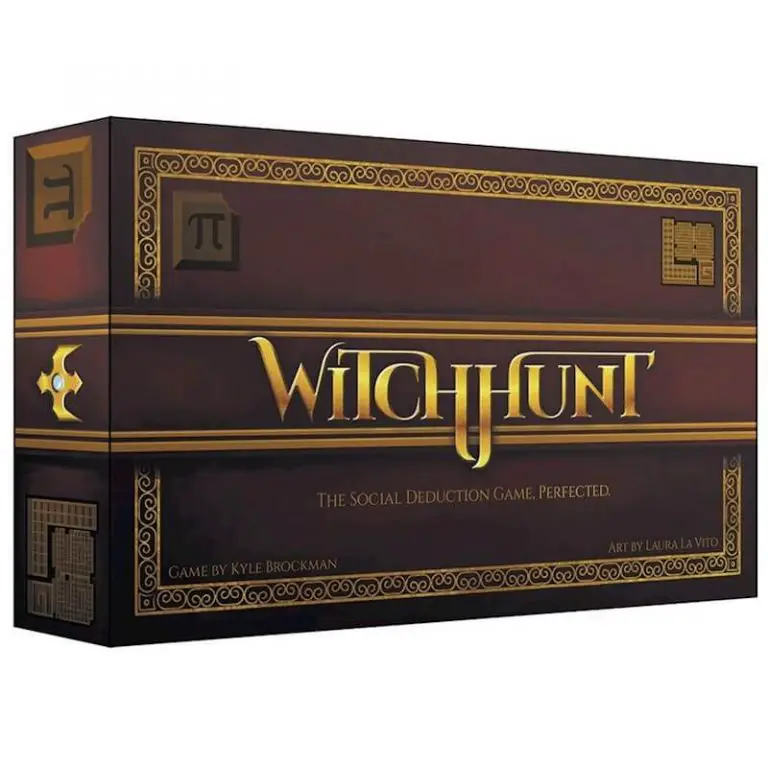
Players: 7 – 22
Duration: 30mins – 90mins
Witch Hunt is a social deduction game that is very similar to Mafia or Ultimate Werewolf, whereby villagers must hunt down and kill witches during the day – while at night the witches kill a villager.
There is a difference though, unlike in the above games. Dead players can still have an effect on the game and influence how decisions are made – Awesome!
Gameplay
At the start of the game one of the players needs to be a moderator. This player simply keeps the game moving and does not actually play.
Each player is dealt a ‘character’ card and a ‘team’ card. These determine the character each player will be in the game and whether they are a villager or a witch.
Once all players have their roles and characters. The moderator tells all players to close their eyes.
One by one the moderator will tell a character to wake up and perform a task before closing their eyes again.
After this has been complete – the day cycle begins.
All player opens their eyes and start discussing who they want to ‘kill’. For a player to be killed a majority of living players needs to be reached. If a majority is not reached by the time period – all players close their eyes and they judge gets to choose a character to die.
Dead players come back as either an Angel or a Demon, depending on if you were a villager or a witch. No cards are turned over when you die – so no one knows if they have killed the right person or not.
The night cycle then repeats itself again – with the moderator telling each character (including angels and demons) to perform their ‘action’ for the night.
After all actions are performed – the witches wake up to kill someone (or not – they can decide)!
The actions of angels and demons are:
- Angels can grant a player an extra life for the night;
- Demons mess with characters – so that if a priest checks one of them he will be told they are on the opposite team than they actually are.
- Angels and Demons never fall asleep – they can see everything that goes on. They are not allowed to communicate with the living at all.
The game continues in the day/night cycle until either all the witches are dead or all the villagers are dead – or rarely, if the moderator determines that one side cannot win.
The game is a unique take on the Mafia / Werewolf hidden role games. Including dead players in the game is a HUGELY awesome mechanic.
It is also cool that each character has a unique ability to use at night – this creates a lot of replay value and makes things super confusing!
Pros:
- Almost endless replayability with role and character cards
- Builds on the classic werewolf and mafia games
- Dead players can still contribute!
Cons:
- The game is a bit more complex to learn than others
- Not for casual players – takes a few rounds to learn
Final Thoughts
Hidden role or Social deduction board games are some of the most socially interactive board games available. The whole premise of the mechanic is to interact with other players.
I tried to implement a good mix of games in my list above that cater for all scenarios and time frames – from the large house party to the intimate 10min clash of wits.
If you haven’t played a hidden role game before, or love the genre and want to try something different, I think there is something for everyone in the above list!

